2 Wire Ceiling Fan To 3 Wire
Kalali
Jun 01, 2025 · 4 min read

Table of Contents
Converting a 2-Wire Ceiling Fan to a 3-Wire Setup: A Comprehensive Guide
Meta Description: Learn how to safely convert a 2-wire ceiling fan to a 3-wire system, enabling the use of a wall switch and enhancing functionality. This guide covers wiring diagrams, safety precautions, and troubleshooting tips.
Many older homes feature ceiling fans wired with only two wires, limiting control options to an on/off switch directly on the fan itself. This can be inconvenient and lacks the flexibility of a wall switch controlling speed and potentially even a light kit. Fortunately, converting a 2-wire ceiling fan to a 3-wire system is a relatively straightforward project, enabling you to add a wall switch for greater control and convenience. This guide will walk you through the process, emphasizing safety and best practices.
Understanding the Wiring: 2-Wire vs. 3-Wire Systems
A 2-wire system typically involves a single hot wire providing power directly to the fan motor. This means the fan is always either fully on or fully off, controlled only by the pull chain switch. A 3-wire system, on the other hand, includes a hot wire, a neutral wire, and a ground wire. The additional neutral wire allows for the use of a wall switch to control the fan's speed and potentially a light kit if equipped. The ground wire provides crucial safety by grounding the fan to prevent electrical shocks.
Necessary Tools and Materials
Before starting, gather these essential items:
- Voltage Tester: To confirm power is off and verify wiring. This is crucial for safety.
- Wire Strippers/Cutters: For preparing wire ends for connection.
- Wire Connectors (Wire Nuts): To securely connect the wires.
- Electrical Tape: For added insulation and security of connections.
- Screwdriver (Phillips and Flathead): For removing the fan and accessing the wiring.
- New 3-Wire Cable (if needed): You may need to run a new cable to the fan location depending on your existing wiring. This will typically need to be routed through the ceiling and potentially walls. Consult a professional if you're uncomfortable with this aspect.
Step-by-Step Conversion Process
1. Safety First: Power Off! Always turn off the power at the breaker box before starting any electrical work. Verify power is off using a voltage tester.
2. Access the Ceiling Fan Wiring: Remove the fan blades and the light kit (if applicable) to access the wiring. Carefully detach the existing wiring from the fan motor.
3. Add the Neutral Wire (if necessary): If your existing wiring is truly just two wires (a hot and a ground), you'll need to add a neutral wire. This usually involves running a new cable from the junction box to the fan motor. This is the most challenging aspect of the conversion and may require professional help if you're not experienced in running electrical cables.
4. Connect the Wires: Connect the hot wire from the ceiling to the corresponding wire on the fan motor. Connect the neutral wire (newly added or existing) to the neutral wire on the fan motor, and the ground wire to the ground wire on the fan motor. Use wire connectors (wire nuts) to secure the connections and cover them with electrical tape for added insulation.
5. Install a Wall Switch: Choose a wall switch compatible with your fan and wiring. Follow the manufacturer's instructions for installation. This usually involves connecting the hot wire from the wall switch to the hot wire coming from the electrical box in the ceiling, and the neutral wire going straight through to the fan's neutral wire.
6. Reassemble the Ceiling Fan: Carefully reattach the fan blades and light kit, ensuring all connections are secure.
7. Test the Fan: Turn the power back on at the breaker box and test the fan using the wall switch. Verify that it functions correctly.
Troubleshooting Tips
- Fan doesn't work: Double-check all wire connections to ensure they're secure and correctly matched. Use a voltage tester to verify power is reaching the fan.
- Fan only works at one speed: The issue might lie with the wall switch itself or its compatibility with the fan.
- Buzzing or humming: This could indicate a loose connection or a problem with the fan motor itself.
When to Call a Professional
If you're uncomfortable working with electricity, or if your existing wiring is complex or requires significant modification (like running new cables), it's always best to consult a qualified electrician. They can safely and efficiently complete the conversion, ensuring your safety and the proper functioning of your ceiling fan. This is particularly important if you lack experience with home electrical wiring. Remember, electrical work can be dangerous if not done properly. Prioritize safety throughout the entire process.
Latest Posts
Latest Posts
-
Why Do I Get Shocked So Much
Jun 03, 2025
-
What To Do With Slack Bx Cables
Jun 03, 2025
-
How To Open Painted Shut Windows
Jun 03, 2025
-
How To Clean A Hot Water Heater
Jun 03, 2025
-
Is Wheat And Whole Grain The Same
Jun 03, 2025
Related Post
Thank you for visiting our website which covers about 2 Wire Ceiling Fan To 3 Wire . We hope the information provided has been useful to you. Feel free to contact us if you have any questions or need further assistance. See you next time and don't miss to bookmark.